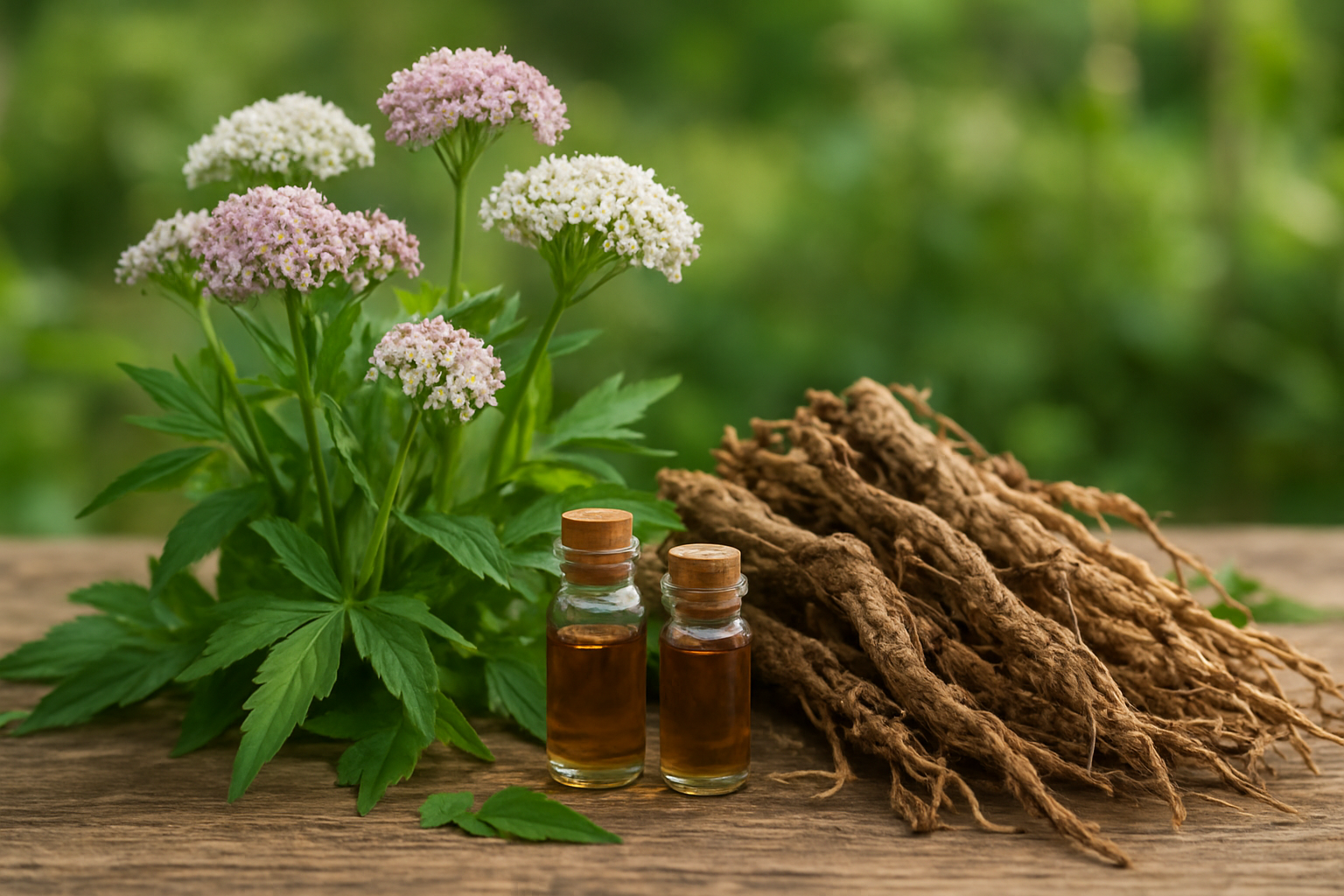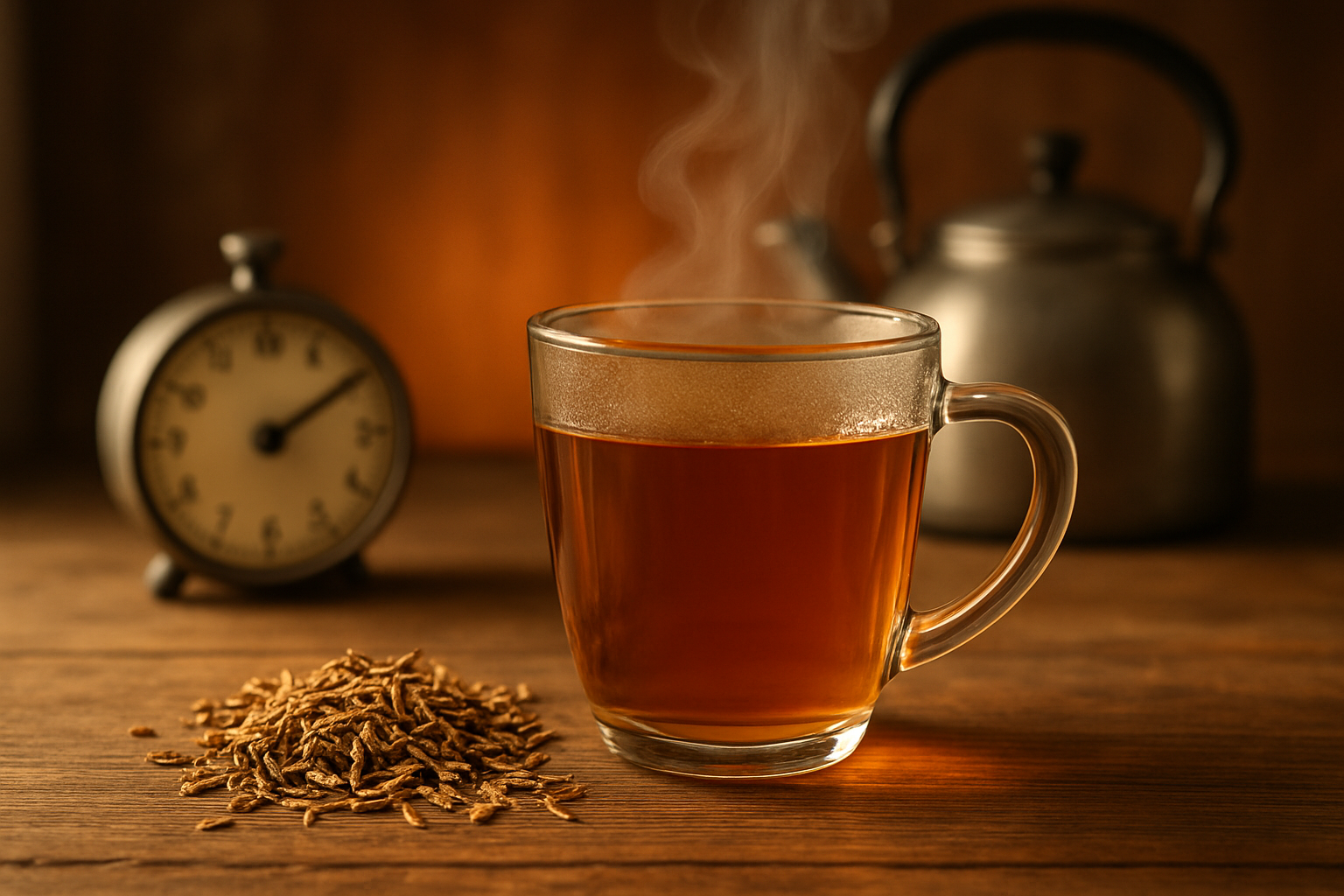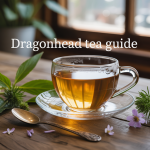Valerian root tea has been helping people wind down and sleep better for centuries, making it one of nature’s most trusted remedies for restless nights and everyday stress. If you’re struggling with sleep issues, anxiety, or simply want to explore natural wellness options, this guide breaks down everything you need to know about this herbal powerhouse.
We’ll dive into the science behind valerian root’s calming effects and explore its proven health benefits, from better sleep quality to reduced anxiety levels. You’ll also learn about important safety considerations and potential side effects, so you can make informed decisions about adding this tea to your routine. Plus, we’ll share expert brewing techniques and timing tips to help you get the most out of every cup.
Understanding Valerian Root and Its Natural Properties

Origins and Botanical Characteristics of Valerian Plant
Valerian (Valeriana officinalis) stands out as one of nature’s most intriguing medicinal plants. This hardy perennial flourishes across Europe, Asia, and North America, thriving in moist meadows, woodland edges, and even roadside ditches. The plant can reach heights of up to five feet, sporting delicate pink or white flowers that bloom during summer months and emit a surprisingly sweet fragrance.
What makes valerian particularly fascinating is the stark contrast between its pleasant-smelling flowers and its notoriously pungent root system. The thick, fibrous roots release an earthy, almost cheese-like odor that many find off-putting at first encounter. This distinctive smell becomes even more pronounced when the roots are dried or processed, earning valerian the nickname “nature’s perfume” among herbalists – though not always meant as a compliment.
The plant’s feathery, compound leaves grow in opposite pairs along sturdy stems, while its extensive root network can spread several feet underground. This robust root system serves as the plant’s powerhouse, concentrating the therapeutic compounds that have made valerian a prized remedy for centuries.
Active Compounds Responsible for Therapeutic Effects
Valerian’s therapeutic magic lies within a complex symphony of bioactive compounds concentrated primarily in its roots. The star players include valerenic acid, isovaleric acid, and various volatile oils that work together to create the herb’s renowned calming effects.
Valerenic acid represents the most studied and potent compound, directly interacting with GABA receptors in the brain – the same pathways targeted by prescription sleep medications. This interaction helps slow down nervous system activity, promoting relaxation and drowsiness. Alongside valerenic acid, isovaleric acid contributes to valerian’s sedative properties while also being responsible for much of that characteristic pungent aroma.
The plant also contains valepotriates, a group of compounds that break down into even more active substances when processed. These include baldrinal and homobaldrinal, which enhance the overall sedative effect. Essential oils like bornyl acetate and beta-caryophyllene add another layer of therapeutic activity, working synergistically with the primary compounds.
What’s particularly interesting is how these compounds work better together than in isolation – a phenomenon scientists call the “entourage effect.” This natural teamwork explains why whole valerian root preparations often prove more effective than isolated compounds.
Historical Use in Traditional Medicine Systems
Valerian’s reputation as a natural tranquilizer stretches back over 2,000 years, with ancient Greek physicians like Hippocrates documenting its use for treating insomnia and nervous disorders. The Romans called it “phu” due to its distinctive smell, but valued it highly for calming hysteria and anxiety.
During medieval times, European herbalists considered valerian so valuable they called it “all-heal.” Monasteries cultivated extensive valerian gardens, and monks used the herb to treat everything from epilepsy to heart palpitations. The plant became so associated with peace and tranquility that it earned the name “garden heliotrope.”
Traditional Chinese Medicine incorporated valerian into formulas for treating restlessness and emotional imbalance, often combining it with other calming herbs. Native American tribes independently discovered similar uses, employing valerian root in ceremonial teas and healing rituals for nervous conditions.
Perhaps most tellingly, during both World Wars, people used valerian tea to cope with anxiety and stress caused by air raids. London hospitals reportedly used valerian preparations to help patients sleep despite the chaos outside, cementing its reputation as nature’s anxiety remedy.
How Valerian Root Differs from Other Herbal Remedies
Unlike many herbal sleep aids that work gradually over weeks, valerian often produces noticeable effects within 30 minutes to two hours of consumption. This relatively quick onset sets it apart from herbs like passionflower or lemon balm, which tend to have milder, more cumulative effects.
Valerian’s mechanism of action also distinguishes it from other popular calming herbs. While chamomile works primarily through gentle muscle relaxation and lavender relies on aromatherapeutic properties, valerian directly influences neurotransmitter activity in ways similar to pharmaceutical sleep aids, though much more gently.
The herb’s safety profile differs significantly too. Unlike kava, which can cause liver concerns with long-term use, or St. John’s wort, which interacts with numerous medications, valerian has relatively few contraindications and a long track record of safe use.
| Herb | Onset Time | Primary Action | Main Benefits |
|---|---|---|---|
| Valerian | 30 minutes – 2 hours | GABA receptor modulation | Deep sleep, anxiety relief |
| Chamomile | 15-45 minutes | Muscle relaxation | Mild sedation, digestive comfort |
| Passionflower | 1-2 hours | General nervous system calm | Stress reduction, mild sleep support |
| Lavender | Immediate (aroma) | Aromatherapeutic | Relaxation, mood enhancement |
Another key difference lies in valerian’s dose-dependent effects. Small amounts may actually be mildly stimulating for some people, while larger doses produce the desired sedative effect – a unique characteristic among herbal remedies that requires more careful dosing attention.
Science-Backed Health Benefits of Valerian Root Tea

Sleep Quality Improvement and Insomnia Relief
Valerian root tea has earned its reputation as nature’s sleep aid through extensive clinical research. Multiple studies demonstrate that compounds like valerenic acid and isovaleric acid work together to increase GABA activity in the brain, promoting natural drowsiness and deeper sleep cycles.
A landmark double-blind study published in the American Journal of Medicine found that participants drinking valerian tea experienced 36% faster sleep onset compared to placebo groups. The research tracked 128 adults over eight weeks, revealing that regular valerian tea consumption led to significantly improved sleep quality ratings and reduced nighttime awakenings.
The root’s sedative properties work differently from synthetic sleep medications. Rather than forcing sleep, valerian gently encourages the body’s natural sleep mechanisms by:
- Reducing nervous system overstimulation
- Lowering cortisol levels during evening hours
- Enhancing slow-wave sleep phases
- Minimizing sleep fragmentation
Clinical trials show that people who struggle with chronic insomnia experience the most dramatic improvements, with sleep quality scores increasing by up to 80% after four weeks of consistent use.
Anxiety and Stress Reduction Capabilities
The calming effects of valerian root extend well beyond sleep support. Research published in Phytomedicine demonstrates that regular valerian tea consumption can reduce anxiety symptoms by 42% within just two weeks of daily use.
Valerian’s anxiolytic properties stem from its ability to modulate the hypothalamic-pituitary-adrenal axis, which controls stress hormone production. The root contains over 150 chemical compounds that work synergistically to promote relaxation without causing dependency or withdrawal symptoms.
Key stress-reduction mechanisms include:
| Mechanism | Effect | Timeframe |
|---|---|---|
| GABA enhancement | Immediate calming | 30-60 minutes |
| Cortisol regulation | Reduced stress response | 1-2 weeks |
| Serotonin support | Mood stabilization | 2-4 weeks |
A randomized controlled trial involving 36 participants with generalized anxiety disorder showed that valerian tea consumption reduced Hamilton Anxiety Rating Scale scores by an average of 5.6 points over four weeks. Participants reported feeling more centered, experiencing fewer racing thoughts, and handling daily stressors with greater ease.
Muscle Relaxation and Tension Relief
Valerian root’s muscle-relaxing properties make it particularly valuable for people dealing with physical tension and mild pain. The herb contains compounds that act as natural muscle relaxants, helping to ease tight shoulders, neck tension, and general muscular discomfort.
Studies show that valerian’s muscle relaxation effects occur through calcium channel modulation and increased magnesium absorption. This dual action helps muscles release stored tension while preventing future cramping and stiffness.
Athletes and individuals with physically demanding jobs report significant benefits from drinking valerian tea after workouts or long days. Research indicates that the tea can:
- Reduce muscle recovery time by up to 25%
- Decrease tension headache frequency by 60%
- Lower overall pain perception scores
- Improve flexibility and range of motion
One study tracked 45 office workers who suffered from chronic neck and shoulder tension. Those who drank valerian tea twice daily reported a 70% reduction in muscle tightness and improved productivity due to decreased discomfort.
Digestive System Support and Comfort
Valerian root tea offers gentle digestive support through its antispasmodic and carminative properties. The herb helps relax smooth muscle tissue throughout the digestive tract, reducing cramping, bloating, and general gastrointestinal discomfort.
Traditional herbalists have long recognized valerian’s digestive benefits, and modern research confirms its effectiveness for various digestive concerns. The root’s volatile oils help regulate gut motility while reducing inflammation in the intestinal lining.
Digestive benefits include:
- Reduced bloating: 45% improvement in post-meal comfort
- Decreased cramping: Particularly effective for stress-related digestive issues
- Better nutrient absorption: Enhanced through improved gut relaxation
- Regulated bowel movements: Gentle normalization without dependency
A clinical study involving 62 participants with irritable bowel syndrome found that daily valerian tea consumption reduced symptom severity by 38% over six weeks. Participants experienced fewer digestive flare-ups during stressful periods, suggesting that valerian’s stress-reducing properties contribute to its digestive benefits.
The tea’s mild bitter compounds also stimulate digestive enzyme production, supporting healthy breakdown and absorption of nutrients from meals. This makes valerian tea an excellent after-dinner beverage for those seeking both digestive comfort and preparation for restful sleep.
Potential Side Effects and Safety Considerations

Common Mild Side Effects and Their Duration
Most people tolerate valerian root tea well, but some experience minor side effects that typically resolve within a few days to a week of regular use. The most common complaint is drowsiness that extends beyond bedtime, leaving some users feeling groggy the next morning. This hangover effect usually diminishes as your body adapts to the herb, typically within 3-5 days.
Headaches affect about 10-15% of new users, often appearing within the first few hours of consumption and lasting 2-4 hours. These are usually mild and can be minimized by starting with smaller doses. Some people report stomach upset, including nausea or mild cramping, particularly when drinking the tea on an empty stomach. Taking valerian with food or after a light snack typically prevents this issue.
Vivid dreams or changes in sleep patterns occur in roughly 20% of users during the first week. While not harmful, these intense dreams can feel unsettling initially. The effect usually normalizes within 7-10 days as your sleep cycle adjusts to the herb’s influence.
Drug Interactions and Contraindications
Valerian root can amplify the effects of sedative medications, creating potentially dangerous levels of drowsiness. Never combine valerian tea with prescription sleep aids like zolpidem (Ambien), eszopiclone (Lunesta), or benzodiazepines such as lorazepam (Ativan) or diazepam (Valium). The combination can lead to excessive sedation, breathing difficulties, and impaired motor function.
Anti-anxiety medications including alprazolam (Xanax) and clonazepam (Klonopin) become significantly more potent when mixed with valerian. This interaction can persist for 24-48 hours after drinking the tea, making activities like driving dangerous even the following day.
Alcohol presents a serious concern when combined with valerian. Both substances depress the central nervous system, and together they can slow breathing and heart rate to dangerous levels. Wait at least 6 hours after drinking alcohol before consuming valerian tea.
Blood thinning medications like warfarin may interact with valerian, though research remains limited. Antihistamines, muscle relaxants, and some antidepressants can also have enhanced effects when combined with valerian root.
Special Precautions for Pregnant and Nursing Women
Pregnancy and breastfeeding require complete avoidance of valerian root tea. While valerian has been used traditionally for centuries, modern safety data for pregnant women remains insufficient. The herb can cross the placental barrier, potentially affecting fetal development, particularly during the critical first trimester when organ formation occurs.
Animal studies suggest valerian may influence uterine contractions, though human data is lacking. Given the potential risks and the availability of safer sleep alternatives during pregnancy, healthcare providers universally recommend avoiding valerian throughout all three trimesters.
Breastfeeding mothers should also skip valerian tea since the herb’s active compounds can pass into breast milk. Infants’ developing nervous systems are particularly sensitive to sedative substances, and even small amounts could affect their sleep patterns, feeding behavior, or overall development.
Women planning to become pregnant should discontinue valerian use at least one month before trying to conceive, allowing the herb to completely clear their system.
When to Consult Healthcare Professionals
Seek medical advice before starting valerian if you take any prescription medications, especially those affecting sleep, anxiety, or mood. Your doctor can review potential interactions and suggest timing strategies to minimize risks.
Contact your healthcare provider immediately if you experience severe drowsiness lasting more than 12 hours after drinking valerian tea, difficulty breathing, chest tightness, or signs of allergic reaction including rash, swelling, or hives.
People with liver disease should consult their doctor before using valerian, as some cases of liver toxicity have been reported with valerian supplements, though causation remains unclear. Those with a history of depression or bipolar disorder need medical supervision, as valerian can occasionally worsen mood symptoms in susceptible individuals.
If you’re scheduled for surgery, stop valerian tea at least two weeks beforehand. The herb can interact with anesthesia and other surgical medications, potentially complicating your procedure and recovery.
Chronic insomnia lasting more than a few weeks warrants professional evaluation regardless of herbal remedies. Persistent sleep problems often signal underlying health conditions that require proper diagnosis and treatment.
Perfect Brewing Techniques for Maximum Potency

Selecting High-Quality Valerian Root Preparations
The quality of your valerian root makes all the difference in brewing an effective tea. Fresh dried valerian root typically offers the most potent results, but you’ll notice its distinctively earthy, almost sock-like aroma – don’t worry, this pungent smell actually indicates good quality and potency.
When shopping for valerian root, look for organic, whole root pieces rather than pre-ground powder. Whole roots maintain their essential oils better and give you more control over the strength of your brew. The root should appear grayish-brown with a fibrous texture and that characteristic strong scent.
Pre-made valerian tea bags can work in a pinch, but they often contain less concentrated amounts of the active compounds. If you choose tea bags, check the ingredient list to ensure valerian root is the primary component, not just a small addition to other herbs.
Store your valerian root in an airtight container away from light and moisture. Properly stored dried root can maintain its potency for up to two years, though fresher is always better for maximum therapeutic benefits.
Optimal Water Temperature and Steeping Times
Getting the temperature and timing right is crucial for extracting valerian’s beneficial compounds without destroying them. Unlike delicate green teas, valerian root can handle higher temperatures, but boiling water isn’t always the best choice.
Heat your water to about 200°F (93°C) – just below boiling point. You’ll see small bubbles forming at the bottom of your pot, but not the rolling boil. This temperature effectively extracts the volatile oils and valerenic acids that give valerian its calming properties.
For steeping time, patience pays off. Valerian root needs longer extraction than most herbs:
- Light brew: 10-12 minutes for mild relaxation
- Standard strength: 15-20 minutes for typical sleep support
- Strong brew: 25-30 minutes for maximum potency
Cover your cup or teapot while steeping to prevent the essential oils from escaping with the steam. The longer steeping times might intensify the earthy flavor, but they also maximize the therapeutic compounds.
Proper Dosage Recommendations for Different Needs
Dosage varies significantly based on your specific needs and individual sensitivity. Start with smaller amounts and gradually increase as needed.
For Sleep Support:
- Begin with 1 teaspoon of dried root per 8 oz of water
- Drink 30-60 minutes before bedtime
- Can increase to 1.5-2 teaspoons if needed
For Anxiety Relief:
- Use 1/2 to 1 teaspoon per cup
- Drink 2-3 times daily as needed
- Space doses at least 4 hours apart
For General Relaxation:
- Start with 1/2 teaspoon per cup
- Safe to drink 1-2 cups daily
- Best consumed between meals
| Need | Root Amount | Water | Frequency |
|---|---|---|---|
| Sleep Aid | 1-2 tsp | 8 oz | Once before bed |
| Anxiety | 0.5-1 tsp | 8 oz | 2-3 times daily |
| Relaxation | 0.5 tsp | 8 oz | 1-2 times daily |
Remember that valerian affects everyone differently. Some people feel drowsy within 30 minutes, while others need consistent use over several days to notice effects. Never exceed 3 grams of dried root per day, and avoid driving or operating machinery after consuming valerian tea, especially when you’re first determining your optimal dosage.
Timing and Usage Guidelines for Best Results

Ideal Consumption Times for Sleep and Relaxation
The timing of your valerian root tea consumption can make or break its effectiveness. For sleep support, drink your tea 30 to 60 minutes before bedtime. This window allows the active compounds to begin working as your natural circadian rhythm starts winding down. The sedative effects typically peak within two hours, making this timing perfect for a smooth transition to sleep.
If you’re using valerian tea for daytime anxiety relief, consume it during lower-activity periods. Mid-afternoon works well for many people, as it won’t interfere with morning alertness or evening sleep preparation. Avoid drinking valerian tea within four hours of important tasks requiring sharp focus, as it may cause drowsiness in sensitive individuals.
Weekend experimentation helps determine your personal response time. Start with smaller amounts during periods when you can safely relax, allowing you to gauge how quickly the tea affects you and how long the effects last.
Frequency Recommendations and Cycle Protocols
Daily valerian tea consumption should follow a structured approach to maintain effectiveness. Most herbalists recommend drinking valerian tea 3-4 times per week rather than nightly. This intermittent schedule prevents tolerance buildup while still providing consistent benefits for sleep quality.
For acute stress periods, you can safely use valerian tea for 7-10 consecutive days. After this period, take a 2-3 day break before resuming regular use. This cycling approach keeps your body responsive to the herb’s natural compounds.
Long-term users benefit from monthly evaluation breaks. After using valerian tea for 4-6 weeks, take a full week off to assess your natural sleep patterns. Many people discover they’ve developed better sleep habits during their valerian tea period, reducing their overall need for herbal support.
Track your usage in a simple journal, noting consumption dates, sleep quality, and any side effects. This record helps identify optimal patterns and prevents overuse.
Combining Valerian Tea with Other Calming Herbs
Valerian root pairs beautifully with complementary herbs that enhance relaxation without causing excessive sedation. Chamomile creates a gentle, well-rounded blend perfect for beginners. The combination provides valerian’s deeper sleep support with chamomile’s mild anxiety relief.
Lemon balm and valerian work synergistically for both sleep and digestive comfort. This pairing helps people whose anxiety manifests as stomach tension. Mix equal parts of each herb for a balanced effect.
Passionflower amplifies valerian’s nervous system benefits. Use a 2:1 ratio of valerian to passionflower for anxiety-related sleep issues. This combination addresses racing thoughts that often prevent restful sleep.
| Herb Combination | Ratio | Best For | Timing |
|---|---|---|---|
| Valerian + Chamomile | 1:1 | General relaxation | 45 minutes before bed |
| Valerian + Lemon Balm | 2:1 | Digestive anxiety | 30 minutes before bed |
| Valerian + Passionflower | 2:1 | Racing thoughts | 60 minutes before bed |
Avoid combining valerian with stimulating herbs like ginseng or yerba mate, as they counteract each other’s effects.
Long-term Usage Considerations and Tolerance Prevention
Valerian tea tolerance develops gradually over months of daily use. Your body adapts to the herb’s compounds, requiring larger amounts for the same effect. Preventing tolerance starts with mindful consumption patterns and regular assessment of your needs.
Rotate between different relaxation strategies to avoid over-reliance on valerian tea. Incorporate meditation, gentle yoga, or warm baths into your routine. This variety keeps valerian as one tool in your wellness toolkit rather than your only solution.
Quality sleep hygiene practices work alongside valerian tea to create lasting improvements. Maintain consistent bedtimes, limit screen exposure, and create a comfortable sleep environment. These foundational habits often reduce your need for herbal support over time.
Monitor your baseline sleep quality during periodic breaks from valerian tea. Many users discover their natural sleep has improved after several months of consistent use, allowing them to reduce frequency or eliminate the herb entirely.
Address underlying stress sources while using valerian tea. The herb provides temporary relief, but lasting change comes from managing root causes of sleep disruption or anxiety.

Valerian root tea offers a natural path to better sleep and relaxation, backed by centuries of traditional use and growing scientific research. From its proven ability to reduce the time it takes to fall asleep to its potential for easing anxiety and stress, this herbal remedy can be a valuable addition to your wellness routine. The key lies in understanding both its benefits and limitations – while generally safe for most people, valerian can interact with certain medications and may cause mild side effects in some users.
Getting the most from valerian root tea comes down to proper preparation and timing. Brewing it correctly with hot water for 10-15 minutes and drinking it 30 minutes to 2 hours before bedtime gives you the best chance of experiencing its calming effects. Start with smaller amounts to see how your body responds, and remember that consistency matters more than intensity when building a natural sleep routine. If you’re struggling with sleep issues or looking for a gentle way to unwind, valerian root tea might be the natural solution you’ve been searching for.














